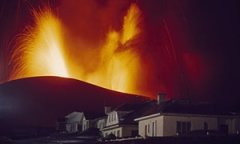Global warming and natural disasters
 Scientists are to outline dramatic evidence that global warming threatens the planet in a new and unexpected way – by triggering earthquakes, tsunamis, avalanches and volcanic eruptions.
Scientists are to outline dramatic evidence that global warming threatens the planet in a new and unexpected way – by triggering earthquakes, tsunamis, avalanches and volcanic eruptions.
Reports by international groups of researchers – to be presented at a London conference next week – will show that climate change, caused by rising outputs of carbon dioxide from vehicles, factories and power stations, will not only affect the atmosphere and the sea but will alter the geology of the Earth.
Melting glaciers will set off avalanches, floods and mud flows in the Alps and other mountain ranges; torrential rainfall in the UK is likely to cause widespread erosion; while disappearing Greenland and Antarctic ice sheets threaten to let loose underwater landslides, triggering tsunamis that could even strike the seas around Britain.
At the same time the disappearance of ice caps will change the pressures acting on the Earth's crust and set off volcanic eruptions across the globe. Life on Earth faces a warm future – and a fiery one.
"Not only are the oceans and atmosphere conspiring against us, bringing baking temperatures, more powerful storms and floods, but the crust beneath our feet seems likely to join in too, " said Professor Bill McGuire, director of the Benfield Hazard Research Centre, at University College London (UCL).
"Maybe the Earth is trying to tell us something, " added McGuire, who is one of the organisers of UCL's Climate Forcing of Geological Hazards conference, which will open on 15 September. Some of the key evidence to be presented at the conference will come from studies of past volcanic activity. These indicate that when ice sheets disappear the number of eruptions increases, said Professor David Pyle, of Oxford University's earth sciences department.
"The last ice age came to an end between 12, 000 to 15, 000 years ago and the ice sheets that once covered central Europe shrank dramatically, " added Pyle. "The impact on the continent's geology can by measured by the jump in volcanic activity that occurred at this time."
In the Eiffel region of western Germany a huge eruption created a vast caldera, or basin-shaped crater, 12, 900 years ago, for example. This has since flooded to form the Laacher See, near Koblenz. Scientists are now studying volcanic regions in Chile and Alaska – where glaciers and ice sheets are shrinking rapidly as the planet heats up – in an effort to anticipate the eruptions that might be set off.


|
Climate Change: Factors Affecting Climate Change, How Climate Change Affects Peoples Lives, And Emergency Plans To Minimize The Effects Of Natural Disasters eBooks |